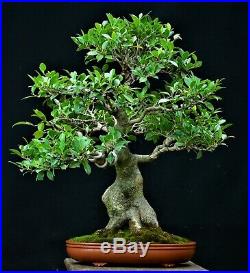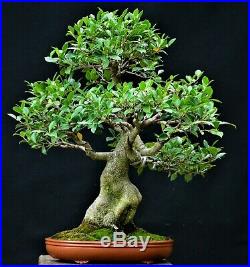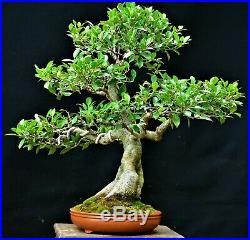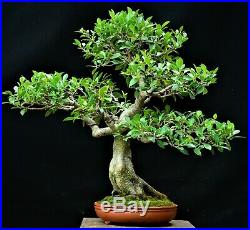





Chinese banyan (Ficus microcarpa – Tiger bark) bonsai – medium size. Height: 23 inches; Width: 25 inches. Pot size 13″ X 10″ X 2 Pot origin: Yixing, China. Trunk diameter at the root base: 6 inches. Popular name: Chinese banyan, Indian laurel. A giant tropical tree, native to India, Shri Lanka, Southern China, Australia, New Caledonia. It loves a humid atmosphere, but it can also tolerate cold temperatures, close to freezing (33 F or 0 C). The largest of the species is known to be on the island of Kauai, Hawai’i, and it is 110 feet tall. In the Buddhist and Taoist religions, many places of worship have large banyan trees. I planted it in my backyard, where it grew in the ground for about 7 years, while the trunk tripled in diameter. Then the development continued in various training pots, where the root work was the main focus, and creating good movement in the trunk. Finally, the fine ramification was achieved in the current bonsai pot, during the past 5 years. During the training process, my main goal was to create large, lower branches, with wide, undulating movements. Also, the nebari is developing fast, and the new owner can soon un-cover more root-base, to show off the beauty of the spreading roots. I like the angular, thick lower trunk, which has a somewhat un-conventional shape. It creates a focal point that attracts the attention of the viewer. The lowest branch has a large wire on it, which will come off in about a month. There are a few more wires, all of them have nearly served their purpose, they will be cut off soon as well. So, the tree will have a finished structure, with no wires on it. The foliaged pads need to be tightly pruned from here on. That will result in smaller leaves and very compact pads. During this season, the pads will become much more defined, and also the owner will have to create nice negative spaces between the pads. Right now, these negative spaces are not so defined, due to the fact the current pads were created last year, so they are still relatively young. But this species is a fast and prolific grower, and in one season a remarcable density can be achieved, with frequent and directional pruning. The red/brown pot nicely contrasts with the grey bark. It is very shallow, which makes the trunk look even bigger. Ficus bonsai is very easy to grow, as long as a warm environment is provided. Because of ease of cultivation, this species is suitable for beginners and experienced alike. The item “Chinese Banyan (Tiger bark) Ficus microcarpa bonsai medium size” is in sale since Monday, April 20, 2020. This item is in the category “Home & Garden\Yard, Garden & Outdoor Living\Plants, Seeds & Bulbs\Plants & Seedlings\Bonsai”. The seller is “world_of_bonsai” and is located in Altadena, California. This item can be shipped to United States.
- Aspect: East-facing
- Bonsai Species: Ficus microcarpa
- Plant Form: Finished Bonsai
- Type: Tropical
- Climate: Sub-tropical
- Sunlight: Full Sun
- USDA Hardiness Zone (°F): 9 (20 to 30 °F)
- Genus: Ficus
- Foliage: Broadleaf
- Indoor/Outdoor: Indoor/Outdoor (winter protection in cold climates
Tags: banyan, bark, bonsai, chinese, ficus, medium, microcarpa, size, tiger





















0